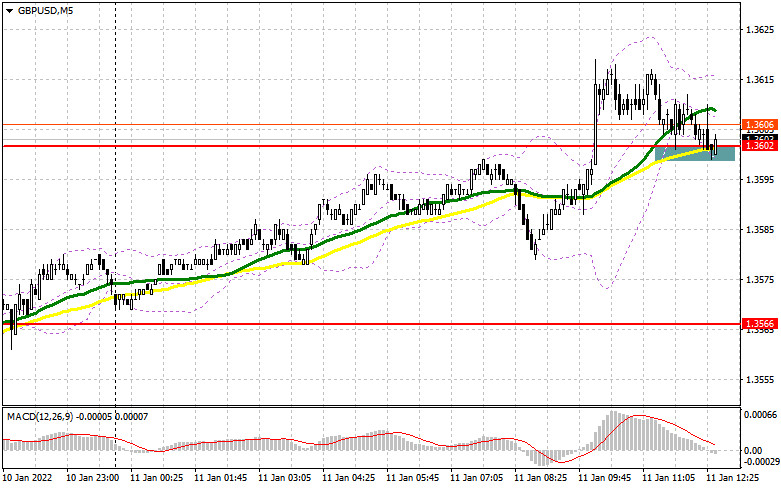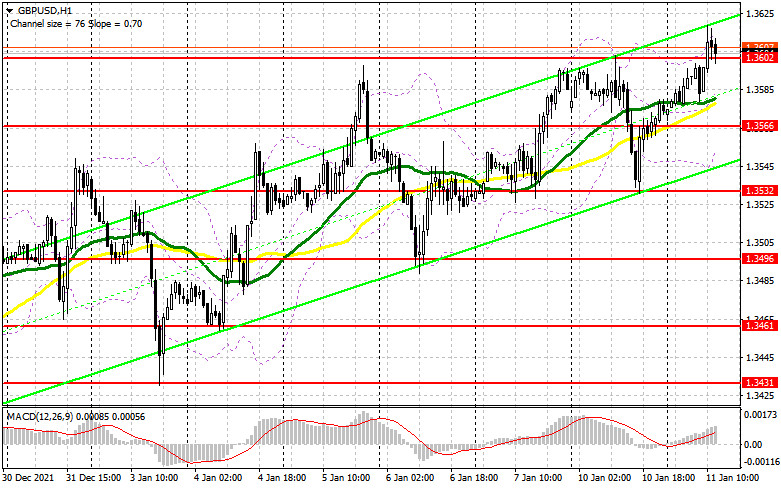To open long positions on GBP/USD, you need:
In my morning forecast, I paid attention to the level of 1.3602 and recommended making decisions on entering the market. Let's take a look at the 5-minute chart and figure out the entry points. The bulls' attempt to gain a foothold at new highs was crowned with success. After the decline and the test of this level from top to bottom, a signal was formed to buy the pound, which is valid at the time of writing. While trading will be conducted above the support of 1.3602, we can count on further recovery of the pair. The technical picture changed only slightly in the afternoon. And what were the entry points for the euro this morning?

The primary task of buyers today is to protect the support of 1.3602, which they managed to win in the first half of the day. In case of another false breakdown formation, more active growth should be observed at this level. If he is not there, the balance of power may change by the time the chairman of the Federal Reserve speaks, so be careful. With the option of further growth of GBP/USD, the nearest target will be the resistance of 1.3649, where I recommend fixing the profits. A more difficult task for the bulls will be to update the highs: 1.3694 and 1.3754. In the scenario of a decline in the pound during the American session and a lack of activity at 1.3602, it is best to postpone purchases to the level of 1.3566, just above which the moving averages are playing on the side of the bulls. To miss this area is tantamount to missing the initiative. Only the formation of a false breakdown there will give an entry point based on the recovery of GBP/ USD. You can buy the pound immediately on a rebound from 1.3532, or even lower - from a minimum of 1.3496, counting on a correction of 20-25 points within the day.
To open short positions on GBP/USD, you need:
The bears missed the market again, allowing the bulls to achieve another monthly high update. However, after a short pause, traders began to take profits on long positions, fearing statements by the chairman of the Federal Reserve System. This returned GBP/USD to the area of 1.3602, for which an active struggle will now begin. A break of 1.3602 and a reverse test from the bottom up of this level will lead to the formation of an excellent sell signal to reduce to the level of 1.3566, for which you will have to fight hard. There, in addition to everything else, there are moving averages that play on the side of the bulls. A breakdown of this range with a reverse test from the bottom up will increase pressure on the pound and dump it to the next support of 1.3532 formed last week. Only consolidation below 1.3532 will give a new entry point into short positions with the prospect of a decline in GBP/USD already to 1.3496 and 1.3461, where I recommend fixing the profits. If the pair grows during the American session and sellers are weak, it is best to postpone sales to a larger resistance of 1.3649. I also advise you to open short positions there only in case of a false breakdown. It is possible to sell GBP/USD immediately for a rebound from a large resistance of 1.3694, or even higher - from a new maximum in the area of 1.3754, counting on the pair's rebound down by 20-25 points inside the day.

The COT reports (Commitment of Traders) for January 4 recorded a sharp increase in long positions and a reduction in short positions - which indicates an increase in the attractiveness of the pound after the Bank of England raised interest rates at the end of last year. If you look at the overall picture, the prospects for the British pound look pretty good. The decisions of the Bank of England continue to support buyers of risky assets in the expectation that the regulator will continue to raise interest rates this year, which will make the pound even more attractive. High inflation remains the main reason why the Bank of England will continue to tighten its monetary policy. On the other hand, the US dollar also has support: inflation data in the US are expected this week, which, together with the recent report on the US labor market, will certainly force the Federal Reserve System to act more aggressively. The first interest rate hikes are planned in the spring, which will make the US dollar more attractive. The COT report for January 4 indicated that long non-commercial positions rose 20,824 to the level of 25,980, while short non-commercial positions fell from the level of 78,510 to the level of 65,151. This led to a serious change in the negative non-commercial net position from -57,686 to -39,171. The weekly closing price rose from 1.3209 to 1.3482.
Signals of indicators:
Moving averages
Trading is conducted above 30 and 50 daily moving averages, which indicates the continuation of the pound's growth further along with the trend.
Note: The period and prices of moving averages are considered by the author on the hourly chart H1 and differ from the general definition of the classic daily moving averages on the daily chart D1.
Bollinger Bands
A breakthrough of the upper limit of the indicator in the area of 1.3615 will lead to a new wave of growth of the pound. A break of the lower limit of the indicator in the area of 1.3560 will increase the pressure on the pound.
Description of indicators
- Moving average (moving average determines the current trend by smoothing out volatility and noise). Period 50. The graph is marked in yellow.
- Moving average (moving average determines the current trend by smoothing out volatility and noise). Period 30. The graph is marked in green.
- MACD indicator (Moving Average Convergence / Divergence - moving average convergence/divergence) Fast EMA period 12. Slow EMA period 26. SMA period 9
- Bollinger Bands (Bollinger Bands). Period 20
- Non-profit speculative traders, such as individual traders, hedge funds, and large institutions that use the futures market for speculative purposes and meet certain requirements.
- Long non-commercial positions represent the total long open position of non-commercial traders.
- Short non-commercial positions represent the total short open position of non-commercial traders.
- Total non-commercial net position is the difference between the short and long positions of non-commercial traders.











